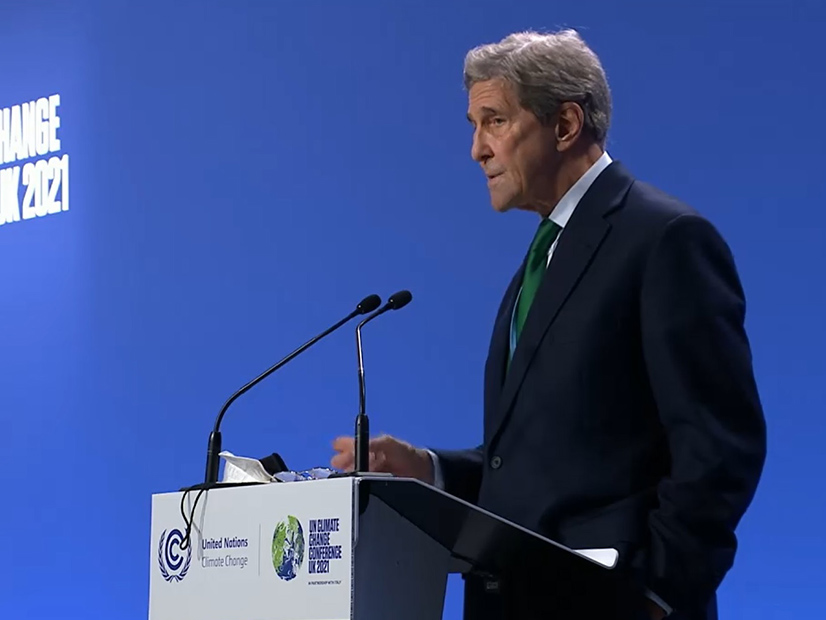
After a whirlwind first week at the U.N. Climate Change Conference (COP26) in Glasgow, Scotland, U.S. Special Presidential Envoy for Climate John Kerry was cautiously optimistic about what the delegation could achieve in Week 2.
Bringing the global community together in the “ultimate test of multilateralism” is not easy, he said, but “this moment … is promising.”
“There is a greater sense of urgency at this COP [Conference of Parties]; there’s a greater sense of focus, and I have never in the first few days of any of the COPs I’ve been to counted as many initiatives and as much real money being put on the table,” he said during a press conference Friday.
Coming out of Glasgow at the end of the conference, countries will have “huge follow-on tasks,” but with it they should have “a level of ambition, a statement of goals and the capacity to get where we need to go that we’ve never had before.”
Countries, he said, are cooperating to produce a strong statement on climate goals that can be implemented.
“All of us have seen years of frustration for promises that are made and not kept,” he said. “We understand that, but I believe that what is happening here is far from business as usual.”
Week 1 Status Check
Commitments to reduce emissions and finance a green and resilient transition came at a fast pace during the first week of COP26 through measurable national pledges and public-private initiatives.
Taken together, existing and updated nationally determined contributions (NDCs) and existing and new initiatives would limit global temperature rise to 1.8 degrees Celsius, according to an International Energy Agency analysis released Thursday. Pledges announced prior to COP26, IEA said, would only limit warming to 2.1 C.
Despite the clear progress, IEA estimated that there is still a 70% gap in the emissions reductions needed by 2030 to keep warming to 1.5 C.
National pledges made last week to cut methane emissions could deliver a reduction of 50 million metric tons by 2030, according to Adair Turner, chair of the Energy Transitions Commission. President Biden on Nov. 2 joined other global leaders in leading a global methane reduction effort that is endorsed by 105 nations. (See US, Canada, EU Pledge to Slash Methane Emissions.)
An additional cut of 80 million metric tons is possible by 2030, very little of which is reflected in current NDCs, Turner said. Updated NDCs, as of Friday, could reduce carbon dioxide emissions by 3 metric gigatons (GT), Turner said.
Globally, he added, CO2 emissions need to drop 22 GT by 2030.
A commitment to end deforestation made Nov. 2 by leaders representing 85% of the world’s forests could reduce CO2 emissions by 3.5 GT, according to Turner.
If countries could agree not to build any new coal plants and phase out existing plants by 2030, CO2 emissions could go down by 3.5 GT, but Turner said that doesn’t look possible given commitments made during Week 1 of the conference.
A group of countries got behind a Coal to Clean Power transition statement, but with large countries such as the U.S., India and China not among the signatories, the agreement would only deliver a 0.2-GT reduction by 2030, he said.
While major industry and transport commitments will come in Week 2 of the conference, the Race to Zero framework and auto manufacturer plans would already reduce CO2 emissions for road transportation by 1.5 GT. The U.N.-led Race to Zero campaign started in 2020 to bring together public and private entities to reach net-zero emissions by 2050, with current participants covering 25% of global CO2 emissions.
All NDCs and sectoral commitments on CO2 emissions would deliver a 9-GT reduction of the 22 GT needed, according to Turner. He expects significant CO2 reduction commitments to come in Week 2, including potential progress in the steel, aviation and shipping sectors.
“But we won’t achieve in Glasgow the full 22 GT we need,” he said. “We won’t be able to leave Glasgow saying, ‘Job done; mission accomplished.’”